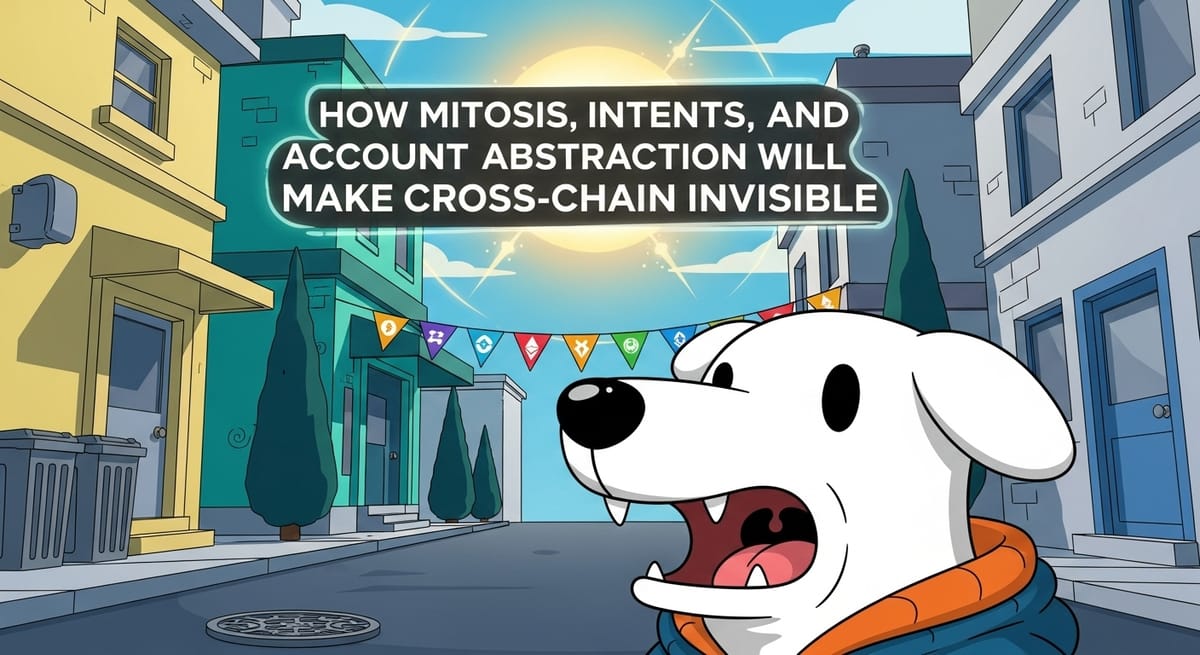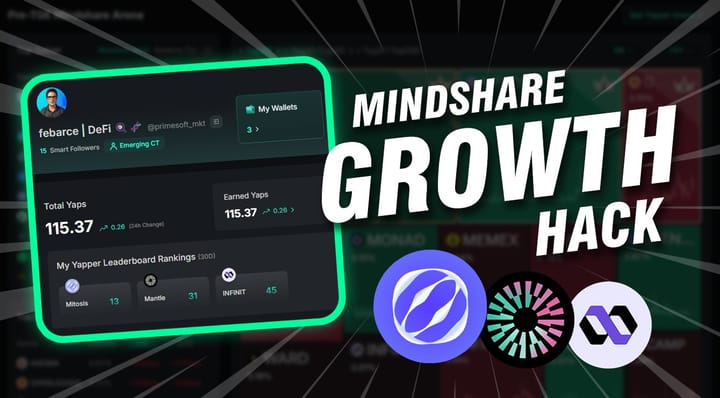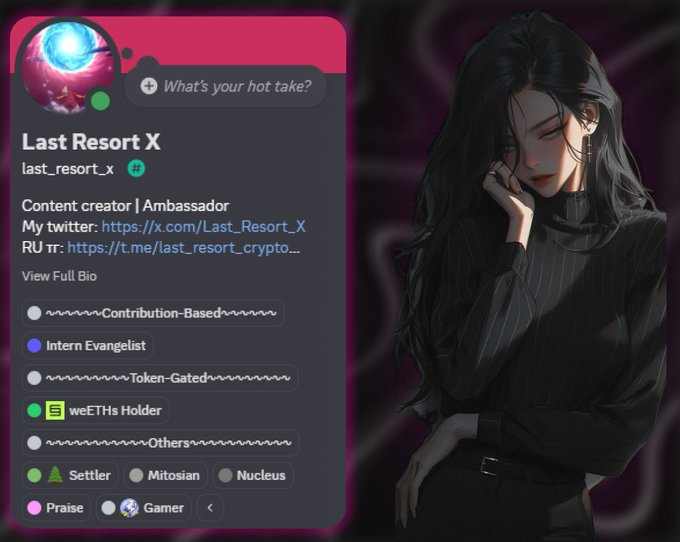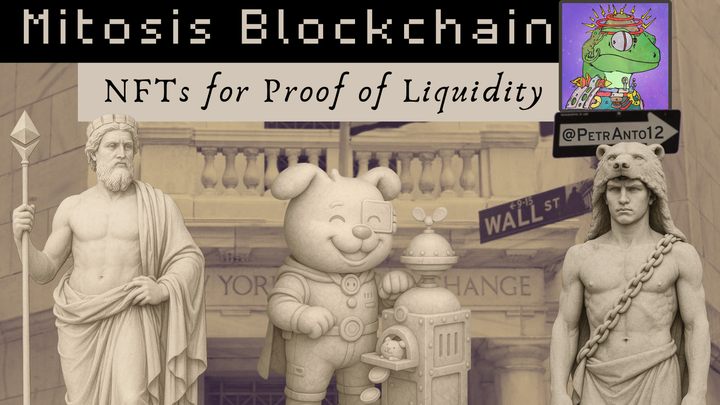How Mitosis, Intents, and Account Abstraction Will Make Cross-Chain Invisible

1. Introduction: The Great Divide Between Web3's Power and Usability
The world of Web3 and decentralized finance (DeFi) is brimming with revolutionary possibilities. Never before has the average user had such direct access to global financial markets, unique digital assets, and decentralized governance. We can trade, lend, invest, play, and create in systems not controlled by any single central party.
However, a huge gap exists between what can be done in Web3 and how easily it can be done. For most people outside of crypto-enthusiasts, the user experience (UX) remains the main barrier:
- Fragmentation: Your assets, favorite dApps, and desired NFTs are scattered across dozens of different blockchains and L2 networks.
- Complexity: You need to manage seed phrases, understand gas fees in different tokens, manually select bridges to transfer assets, and sign multiple transactions to perform a single complex action.
- High "Mental" Barrier: The user is forced to constantly think like a "system administrator" of their own bank, rather than a regular consumer of a service.
This poor UX is the primary reason why Web3 has yet to become truly mainstream. People want to enjoy the benefits of decentralization, but they don't want to navigate a labyrinth of technical complexities.
Three Technologies That Will Change Everything
Fortunately, the industry is actively working to solve this problem. Three key technological trends are now coming to the forefront, which, when combined, promise to bring about a true revolution in UX and make interacting with Web3 as simple as using a modern smartphone.
- Account Abstraction (AA): A technology (best known through the ERC-4337 standard) that turns wallets into programmable smart contracts. This enables features like social recovery (forgetting about seed phrases), paying for gas with any token, and executing multiple operations in a single transaction. AA simplifies wallet management.
- Intent-Based Architectures (Intents): This is a paradigm shift from executing specific transactions to expressing a desired outcome. The user doesn't say "swap token A for B, then send it to bridge C, then stake it in protocol D," but simply declares an intent: "I want to stake token A in the highest-yielding pool D." Intents simplify task execution.
- Cross-Chain Infrastructure (like Mitosis): This is the underlying "transport" layer that ensures the secure and efficient movement of assets and data between different blockchains. Cross-chain infrastructure makes tasks possible in a multichain environment.
Individually, each of these technologies solves an important part of the problem. But their true magic is unleashed only when they work together.
Mitosis as the "Invisible" Foundation for a New UX
In this new paradigm, Mitosis plays the role of key, but invisible to the user, infrastructure. When a user expresses their cross-chain intent (e.g., "transfer USDC from Arbitrum and buy an NFT on Solana"), a system of "solvers" working with intents must find the optimal path. And to actually move the value, it needs a reliable and liquid "transport."
This is precisely where Mitosis, with its Ecosystem-Owned Liquidity (EOL) model and security based on EigenLayer AVS, becomes indispensable. It provides:
- Reliable rails for the secure movement of assets.
- The necessary liquidity for fast and efficient swaps and transfers.
An intent "solver" can simply "call" Mitosis to handle the cross-chain part of the task, without forcing the user to choose a bridge and figure out how it works.
What Will You Learn From This Article?
In this article, мы подробно рассмотрим, как эта синергия трех технологий формирует будущее Web3 UX:
- We will break down a specific example of what the ideal user journey might look like in a world where AA, intents, and Mitosis work together.
- We will analyze how each technology complements the others, creating a single, seamless experience.
- We will discuss why creating an "invisible" cross-chain is the Holy Grail the entire industry is striving for, and what role Mitosis plays in this.
Get ready to look into a future where the complexity of Web3 is hidden "under the hood," and users can finally focus on what matters most – their goals, not the tools to achieve them.
2. The Ideal User Journey: How It Will Work in Practice
The theory sounds promising, but what will user interaction with Web3 look like in a world where Account Abstraction, Intents, and Mitosis work in unison? Let's break down a hypothetical but entirely realistic scenario.
Scenario: "I want to earn yield on my USDC"
Let's imagine Alice. She has 1,000 USDC in her smart wallet on the Arbitrum network. She's heard about high yields in DeFi but doesn't want to deal with dozens of protocols and networks.
Step 1: Expressing the Intent (The User's Task)
Alice opens her smart wallet (which supports intents). Instead of searching for protocols, she goes to the "Investments" or "Yield" section and simply writes or selects her intent from a list of options:
"Deploy my 1,000 USDC into the strategy with the highest stable yield and moderate risk."
She presses a single "Execute" button and confirms the action in her wallet. For Alice, that's it. Her interaction with the system is complete.
Step 2: The "Under the Hood" Work Begins (The System's Task)
Now, a complex system composed of several components takes over:
- Intent Aggregator/Solver: This service receives Alice's intent. Its job is to find the best way to execute it. It scans hundreds of DeFi protocols across dozens of blockchains (Ethereum, Polygon, Solana, Base, etc.), analyzing:
- Current APY rates in lending protocols.
- Yield in stablecoin liquidity pools.
- The reliability and security of these protocols.
- The cost of all necessary transactions (gas, bridge fees).
- Finding the Optimal Path: The "solver" concludes that the best and most suitable strategy according to the risk criteria at the moment is to provide liquidity in a USDC/USDT pair on a new but reliable DEX on the Polygon blockchain.
- Creating the Route: The "solver" constructs the optimal execution route:
- Take 1,000 USDC from Alice's wallet on Arbitrum.
- Use Mitosis to transfer the 1,000 USDC from Arbitrum to Polygon.
- On Polygon, swap approximately 500 USDC for USDT on the most favorable DEX.
- Provide ~500 USDC and the resulting USDT to the liquidity pool on the target DEX.
- Receive LP tokens and stake them to earn additional income (if this is part of the strategy).
Step 3: The Role of Mitosis – Seamless Liquidity Transport
In the third step of the route, the "solver" calls on Mitosis as an infrastructure provider.
- Invoking Mitosis: The "solver" initiates the cross-chain transfer via Mitosis. It doesn't need to worry about the security of this transfer because it trusts Mitosis's reputation and technology (AVS, EOL).
- Fast and Efficient Transfer: Mitosis, using its EOL liquidity on Polygon, quickly provides the 1,000 USDC needed for the next steps, while the settlement process between the networks happens on the protocol's internal level.
- Gas Payment (The Role of Account Abstraction): All gas fees (on Arbitrum for sending, on Polygon for swapping and staking) can be paid automatically. A Paymaster working with Alice's smart wallet can "withhold" a small portion of her initial USDC to cover all expenses, using Mitosis to transfer these funds if necessary. Alice doesn't need to have native tokens (ETH on Arbitrum, MATIC on Polygon) in her balance.
Step 4: The Result for the User
After a short time, Alice receives a notification in her wallet:
"Your intent has been executed. 1,000 USDC has been successfully deployed into the 'XYZ' strategy on Polygon with an estimated yield of 15% APY. You can track your earnings here."
She sees a new position in her portfolio, but she didn't have to leave her wallet, deal with bridges, buy MATIC for gas, or sign 5 different transactions. All the complexity was completely abstracted away.
Conclusion: A New Paradigm of User Experience
This example clearly shows how the synergy of three technologies – Account Abstraction, Intents, and Mitosis – creates a completely new user experience that can be called "invisible" cross-chain.
- Account Abstraction removes the headache of seed phrases and gas.
- Intents allow the user to focus on their goals, not the process.
- Mitosis serves as a reliable and efficient foundation that makes the execution of these cross-chain goals possible, working silently "under the hood."
This is the future that Web3 is striving for to become truly mainstream. It's a world where technology becomes an invisible assistant, not an obstacle. And Mitosis, as a key protocol for unifying liquidity, plays a central role in building this future by providing the "circulatory system" for the free and secure movement of assets according to users' desires.
Learn more about Mitosis:
- Explore details on the official website: https://www.mitosis.org/
- Follow announcements on Twitter: https://twitter.com/MitosisOrg
- Participate in discussions on Discord: https://discord.com/invite/mitosis
- Read articles and updates on Medium: https://medium.com/mitosisorg
- Blog: https://blog.mitosis.org/



Comments ()